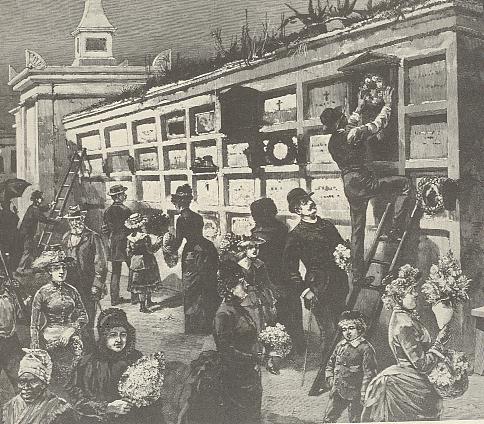
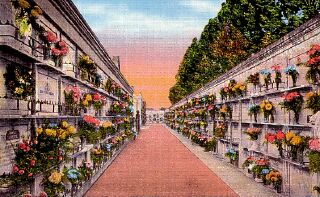
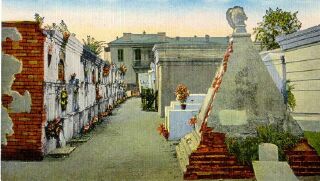
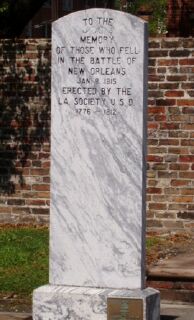
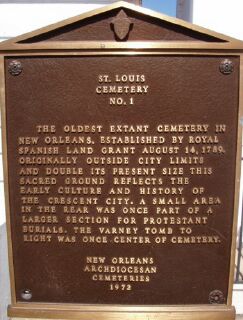
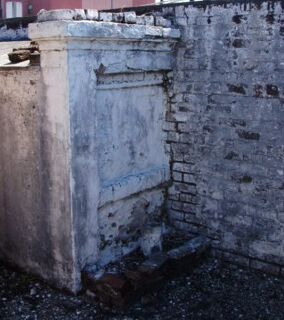
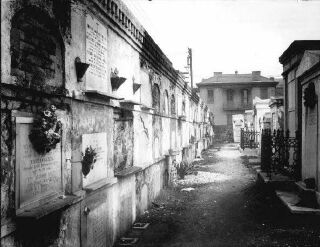
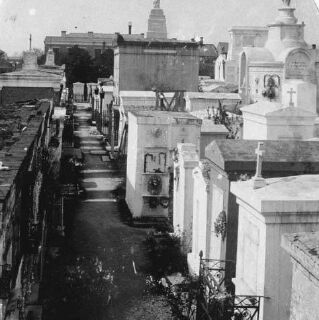
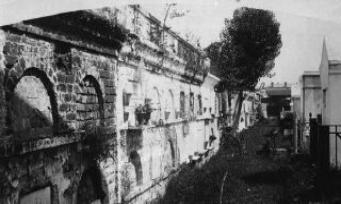
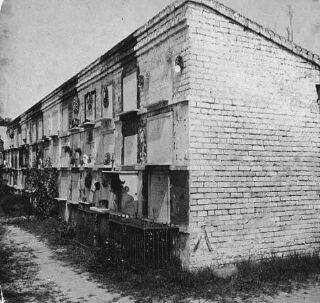
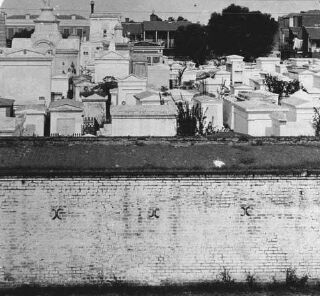
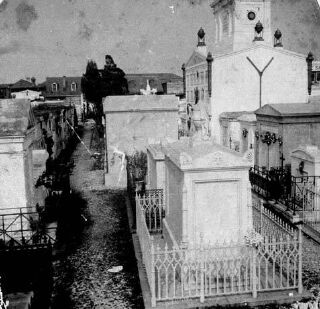
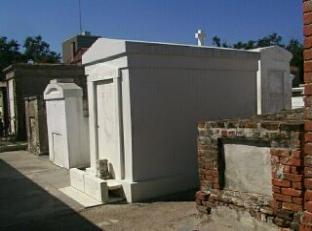
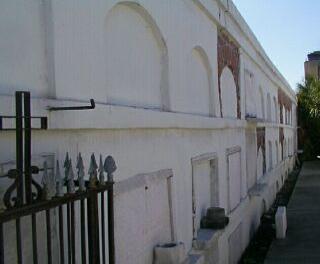
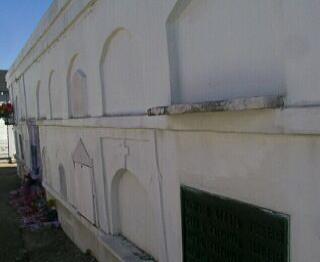
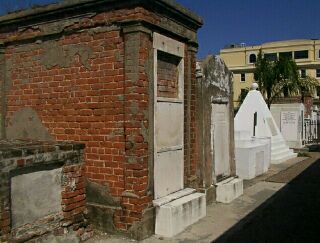
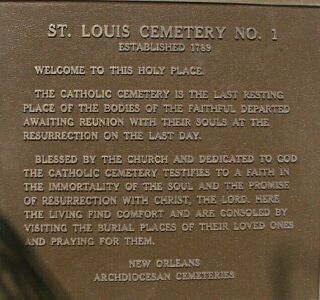
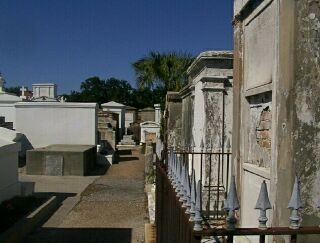

| St. Louis Cemetery Number One The oldest remaining cemetery in the city of New Orleans, established 1789 |
| Images - Past and Present |
The first time I visited St. Louis Cemeteries One and Two, I was about seven years old and with my
dad, who is the one who gave me an appreciation for historic cemeteries. For those who can't pass
an ancient cemetery without stopping to walk among the aging tombstones, the St. Louis Cemeteries
are the holy grail of burying grounds in the city of New Orleans.
For over two hundred years, up to and including the present time, citizens of the city have been laid
to rest in the tombs and vaults of St. Louis Cemeteries One and Two.
These are the tombs of the people who settled and built the city of New Orleans. Although, St. Louis
Number One was not the first cemetery established in New Orleans, it is the oldest cemetery that
remains today. Nearly every notable family name associated with the history of the city can be found
here; as well as citizens, whose names may not be recognizable, but who, also, contributed to the
city's history. Pirates, politicians, heroes of the Battle of New Orleans, a voodoo queen, an
international chess champion and many victims of the Yellow Fever epidemics are among the
citizens buried within the cemetery's walls; which, also, contain the tombs of French, Italian,
Portuguese and Spanish Societies.
As every New Orleans school child--and well-read tourist--knows, the reason for the above-ground
tombs has to do with the water table beneath the city. The first cemetery, St. Peter's, est. 1721,
which was located in the French Quarter proper, began with in-ground graves. But people soon
learned the futility of this practice. With every heavy rain, caskets had a tendency to bob to the
surface in a pool of collected rain water. Needless to say, this was neither desired by or healthy for
the residents, especially when you consider the number of contagious epidemics from which the
citizens of the city suffered and died on a regular basis, the most famous and costly being the Yellow
Fever epidemics of the 18th and 19th centuries.
So, when land was readied outside of the city walls for the first St. Louis Cemetery, the powers that
be determined to build only above-ground tombs and vaults out of necessity to the conditions of
their environment. In the midst of the worst Yellow Fever epidemics of the 19th century, the Yellow
Fever Mortuary Chapel was built a few blocks away from St. Louis Number One Cemetery, so that the
bodies of the fever victims could be carried to the cemetery from the chapel, without the funeral
procession going through the city's streets. To read the history of the Chapel, click here.
The age of many of the cemeteries of New Orleans, as well as the climate and other factors, require
ongoing work to keep them from further deterioration. The task is never finished, but the dedicated
volunteers of Save Our Cemeteries have done yeoman's work in saving and restoring many
historical tombs. To visit their website and read more about their important work, click here.
I visited St. Louis Cemetery Number One in October, 2006. It was the first time I'd been to the
cemetery in a long while. I took the photographs on the bottom half of this page on that day.
The flood waters of the levee failures rose two to three feet deep in St. Louis Number One, but
when they receded, the venerable old tombs were none the worse for wear. The tombs and statues
and walkways of the old cemetery have witnessed and survived many sorrows in their 200 plus
years. The 2005 flood was one more to add to their long and storied history. -- Nancy Brister
dad, who is the one who gave me an appreciation for historic cemeteries. For those who can't pass
an ancient cemetery without stopping to walk among the aging tombstones, the St. Louis Cemeteries
are the holy grail of burying grounds in the city of New Orleans.
For over two hundred years, up to and including the present time, citizens of the city have been laid
to rest in the tombs and vaults of St. Louis Cemeteries One and Two.
These are the tombs of the people who settled and built the city of New Orleans. Although, St. Louis
Number One was not the first cemetery established in New Orleans, it is the oldest cemetery that
remains today. Nearly every notable family name associated with the history of the city can be found
here; as well as citizens, whose names may not be recognizable, but who, also, contributed to the
city's history. Pirates, politicians, heroes of the Battle of New Orleans, a voodoo queen, an
international chess champion and many victims of the Yellow Fever epidemics are among the
citizens buried within the cemetery's walls; which, also, contain the tombs of French, Italian,
Portuguese and Spanish Societies.
As every New Orleans school child--and well-read tourist--knows, the reason for the above-ground
tombs has to do with the water table beneath the city. The first cemetery, St. Peter's, est. 1721,
which was located in the French Quarter proper, began with in-ground graves. But people soon
learned the futility of this practice. With every heavy rain, caskets had a tendency to bob to the
surface in a pool of collected rain water. Needless to say, this was neither desired by or healthy for
the residents, especially when you consider the number of contagious epidemics from which the
citizens of the city suffered and died on a regular basis, the most famous and costly being the Yellow
Fever epidemics of the 18th and 19th centuries.
So, when land was readied outside of the city walls for the first St. Louis Cemetery, the powers that
be determined to build only above-ground tombs and vaults out of necessity to the conditions of
their environment. In the midst of the worst Yellow Fever epidemics of the 19th century, the Yellow
Fever Mortuary Chapel was built a few blocks away from St. Louis Number One Cemetery, so that the
bodies of the fever victims could be carried to the cemetery from the chapel, without the funeral
procession going through the city's streets. To read the history of the Chapel, click here.
The age of many of the cemeteries of New Orleans, as well as the climate and other factors, require
ongoing work to keep them from further deterioration. The task is never finished, but the dedicated
volunteers of Save Our Cemeteries have done yeoman's work in saving and restoring many
historical tombs. To visit their website and read more about their important work, click here.
I visited St. Louis Cemetery Number One in October, 2006. It was the first time I'd been to the
cemetery in a long while. I took the photographs on the bottom half of this page on that day.
The flood waters of the levee failures rose two to three feet deep in St. Louis Number One, but
when they receded, the venerable old tombs were none the worse for wear. The tombs and statues
and walkways of the old cemetery have witnessed and survived many sorrows in their 200 plus
years. The 2005 flood was one more to add to their long and storied history. -- Nancy Brister
| The photos in this section were taken by George Francois Mungier in the mid-1890's. |

| Taken in the 1920's |
| The Varney pyramid shaped tomb, which stands near the Basin Street entrance. Much of the cemetery has been taken over by widening of streets, this tomb once stood in the middle of the cemetery, now it's near one of the walls; photo ca. 1920's |

| The photos in this section were taken on October 28, 2006. |
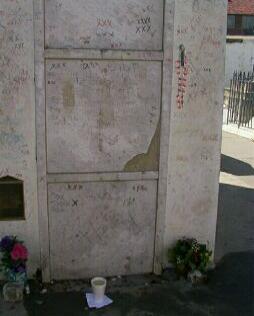
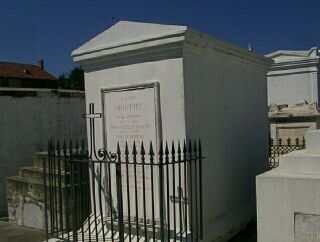
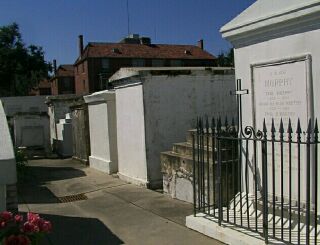
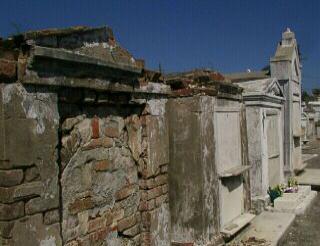
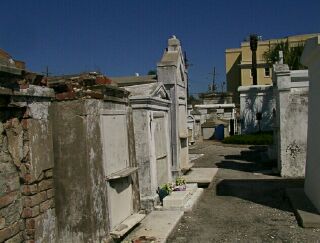
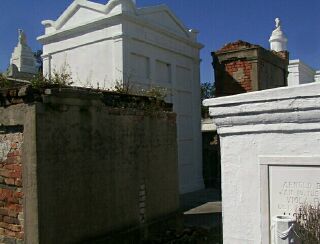
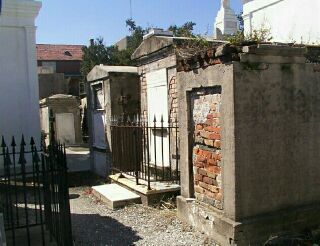
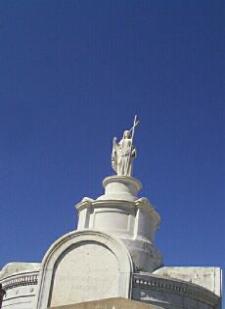
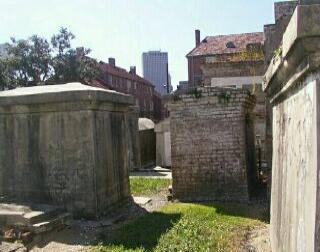
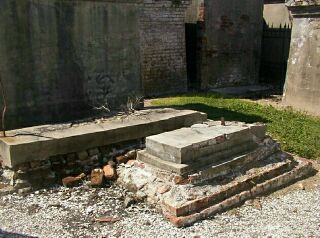
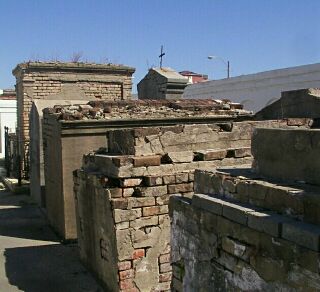
| "The oldest extant cemetery in New Orleans, established by Royal Spanish Land Grant August 14, 1789. Originally outside city limits and double its present size, this sacred ground reflects the early culture and history of the crescent city. A small area in the rear was once part of a larger section for Protestant burials. The Varney tomb to the right was once the center of cemetery." New Orleans Archdiocesan Cemeteries |
| "Welcome to this holy place. The Catholic Cemetery is the last resting place of the bodies of the faithful departed awaiting reunion with their souls at the resurrection on the last day. Blessed by the church and dedicated to God, the Catholic Cemetery testifies to a faith in the immortality of the soul and the promise of resurrection with Christ, the Lord. Here the living find comfort and are consoled by visiting the burial places of their loved ones and praying for them. New Orleans Archdiocesan Cemeteries |
| The link to this page is: http://old-new-orleans.com/NO_St_Louis_Number1.html Back to Old New Orleans Whispers - Home |

| Sketch from Harper's Weekly, 1893: decorating the tombs, St. Louis Number 1 on All Saints Day. |
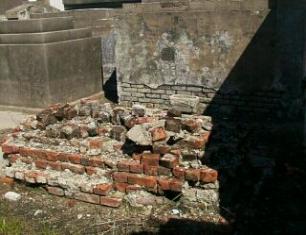
| Note the Varney tomb mentioned above, to the right in this photo, it's been restored since the 1930's picture. |
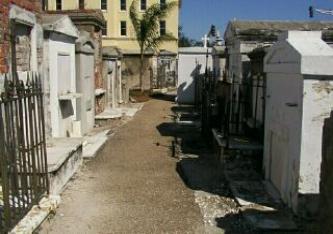
| These tombs, known as wall vaults, are arranged along the walls of the cemetery and are individually owned. |
| The supposed tomb of the famous voodoo priestess, Marie Laveau. The plaque reads: "This Greek Revival tomb is reputed burial place of this notorious 'voodoo queen.' A mystic cult, voodooism, of African origin, was brought to this city from Santo Domingo and flourished in 19th century. Marie Laveau was the most widely known of many practitioners of the cult." As you can see, people still make markings on her tomb and bring offerings, in hope of securing favors. Mardi Gras beads hang on the right side of the tomb. The cup sitting on a napkin in front of the tomb looks like it contains coffee. Since she was a hair dresser, you can often find combs, shampoo and other hair products placed there. |
| The tomb of Paul Morphy, international chess champion. Fans still bring chess pieces from time to time to leave at his tomb. |
| Some of the tombs and vaults are still in use today and are kept in good condition by the families who own |
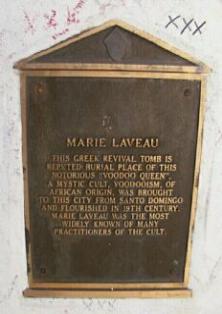
| The two tombs in the left photos belong to a mother and daughter, victims of the 1853 Yellow Fever epidemic. This type of tomb is called a "stepped tomb;" there are very few of them located in the cemetery. The ones that haven't been restored are sinking and deteriorating badly. |
| Tomb built into the cemetery wall. |
| The Battle of New Orleans Monument reads: "To the memory of those who fell in the Battle of New Orleans, January 8, 1815, Erected by the LA Society USD, 1776-1812" A monument to memorialize those buried here who were killed in the Battle of New Orleans is in the Protestant section of the cemetery; most of the men buried in this section were from Tennessee and Kentucky. |
| Sculptures on three of the tombs: left, statue of Mary; middle, known as "the praying woman;" right, known as "the weeping woman." |
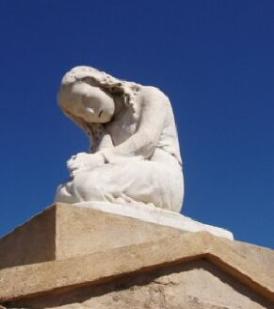
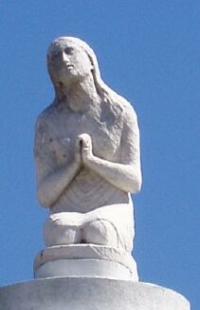
| ~ ~ ~ ~ ~ |
